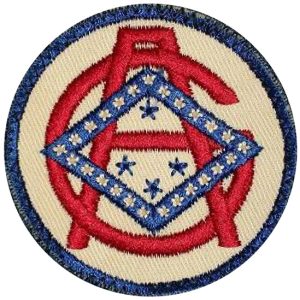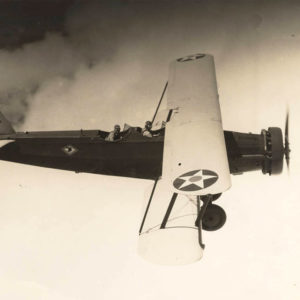calsfoundation@cals.org
Arkansas State Guard
The Arkansas State Guard was a military force that performed homeland defense, disaster relief, and search-and-rescue duties during World War II while the Arkansas National Guard was in federal service. From 1942 to 1946, this volunteer military force helped fight floods along the Arkansas and Ouachita rivers, looked for missing persons, and assisted in recovery efforts following devastating tornadoes around the state.
The State Guard was authorized by Act 85 of 1929 of the Arkansas General Assembly, which allowed for its organization whenever at least seventy-five percent of the Arkansas National Guard was called into federal service. The need for this type of unit was proven during World War I when, after the three Arkansas National Guard regiments were federalized, sixty-four Home Guard companies were formed around the state to serve in their place.
Soon after the 154th Observation Squadron was activated for training in September 1940, Governor Homer Adkins and Adjutant General Ebenezer L. Compere began to receive letters from members of local American Legion and Veterans of Foreign War posts recommending the organization of a state guard. However, as the National Guard was only expected to be gone for a year, state officials declined to take this action, as it was not thought to be an efficient use of state resources. However, by November 1941, attitudes had changed, and plans for a state guard were rushed to completion after the attack on Pearl Harbor.
Hendrix Lackey began service as commander of the Arkansas State Guard on January 12, 1942. Colonel Lackey was born in Mountain View (Stone County), graduated from Hendrix College, and was a World War I veteran who worked in general merchandise, insurance, and the automotive industry before World War II. He also served as assistant adjutant general, a position he stepped down from in 1945 to head the Arkansas Economic Development Commission while retaining command of the State Guard.
The State Guard was originally organized as the Sixth Arkansas Infantry regiment with a headquarters company and two battalions of infantry, each with a medical detachment. But as the State Guard later expanded to 1,500 men, the First Separate Battalion was created in southeast Arkansas and a provisional battalion was formed in Little Rock (Pulaski County). Standard infantry companies were composed of fifty-five enlisted men and were commanded by a captain with the assistance of two lieutenants. Many State Guardsmen were veterans of World War I, with an average age of thirty-two for enlisted men and forty-one for officers, they were now too old for federal military duty but desired to continue to serve the country and the state in any way they could. State Guardsmen attended weekly drills but were not paid except when on active duty in response to emergencies or in annual training schools.
Most of 1942 was spent in organizing and equipping the initial units of the State Guard, and their first service apparently occurred when they were detailed to guard dams near Hot Springs (Garland County). However, their first significant mobilization was not until November 1–3, 1942, when Company G of Rogers (Benton County) was called out to direct traffic and guard property after a devastating tornado in Berryville (Carroll County). Tornadoes near Camden (Ouachita County) in April 1944 and in Johnson County in April 1945 also prompted State Guard alerts to assist in rescue and relief work.
The first large-scale deployment of the State Guard occurred in May 1943 when it was tasked to help fight massive flooding along the Arkansas River. For up to three weeks, about 450 Guardsmen patrolled levees, assisted in evacuation of flooded areas, stood guard duty, repaired waterlines, and crewed boats on the river. The State Guard was again called on to perform similar duties during flooding on the Arkansas and Ouachita rivers in April 1945.
The State Guard performed search-and-rescue missions beginning in November 1943 when the Rogers company assisted in the search for a missing child in Searcy County, as well as the following month when the Arkadelphia (Clark County) company responded after a man went missing near Malvern (Hot Spring County). In May 1944, units from Batesville (Independence County), Searcy (White County), and Blytheville (Mississippi County) searched for a missing teenager near Mountain View, and, in July, the State Guard helped look for a missing woman in Devil’s Den State Park. Besides responding to emergencies, the State Guard also participated in community events such as parades, and at least one company assisted in the mobilization of draftees for federal service by manning the armory in which groups of draftees were mobilized.
Subsequent to the reorganization of the Arkansas National Guard, the Arkansas State Guard was disbanded on December 16, 1946, and though still authorized, the State Guard has not been manned or organized since World War II. With Act 670 of 1985 and Act 283 of 1989, the state legislature approved revisions to the state military code and allowed for the State Guard’s reactivation by the governor whenever any part of the National Guard is in federal service or in any other emergency.
For additional information:
Adjutant General Correspondence, 1941–1945. Arkansas State Archives, Little Rock, Arkansas.
Stentiford, Barry M. The American Home Guard: The State Militia in the Twentieth Century. College Station: Texas A&M University Press, 2002.
D. Blake Sasse
Maumelle, Arkansas
 World War II through the Faubus Era, 1941 through 1967
World War II through the Faubus Era, 1941 through 1967 154th Observation Squadron
154th Observation Squadron  Arkansas State Guard Patch
Arkansas State Guard Patch  Captain Edward S. Lee
Captain Edward S. Lee  PT-1 Trainer
PT-1 Trainer 




I enlisted in ASG when I was 16 years old and lived in Levy, Arkansas (during WWII). I was sent to Camp Robinson for training and made corporal before opting out and enlisting in the U.S. Navy. I still have an ASG shoulder patch and my cap with its infantry braid. We were furnished uniforms and were armed by the U.S. government with 1917 Enfield Rifles (complete with bayonets) and a few Thompson sub-machine guns. Col. Guy Hendrix Lackey was state commander, and Capt. Gordon E. Wood was our company commander. Our armory, which exited onto 3rd street North Little Rock, Arkansas, was in one of the school buildings there. Not much else, as WWII took me away.